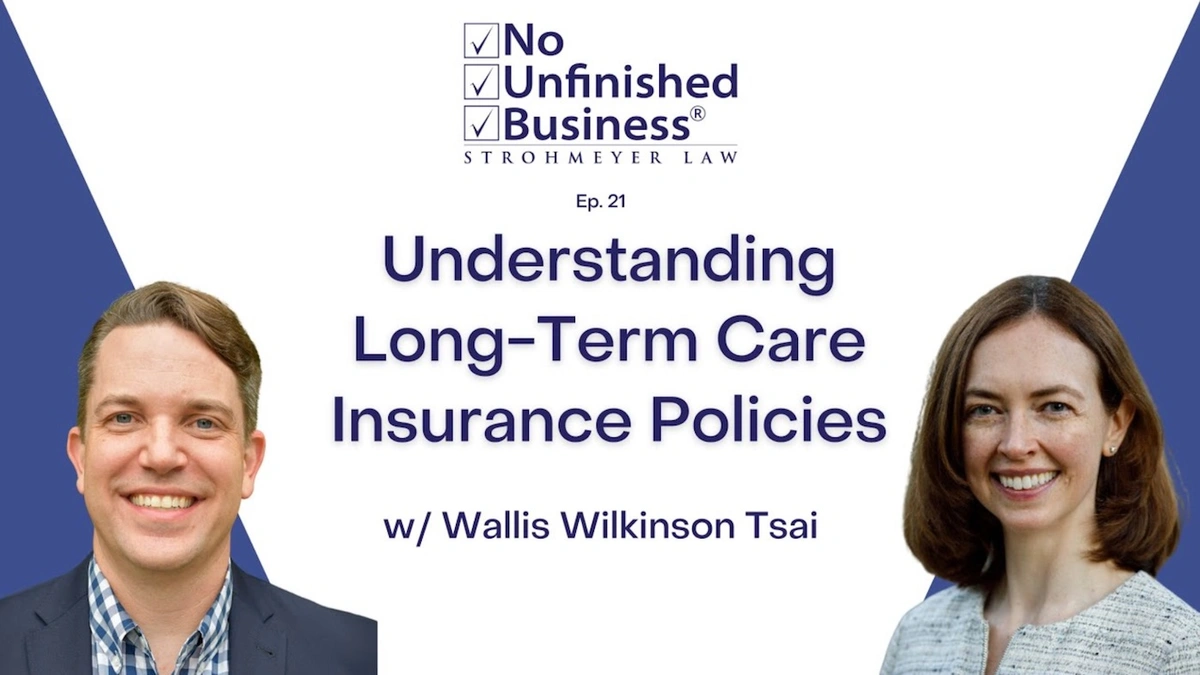Did you know that more than half of people reaching age 65 will need long-term care during their lives?1
The “dream scenario” is that we live long, healthy lives and then pass peacefully in our sleep after achieving a ripe old age and a joyous, active life well-lived.
But the reality for most of us will be trickier than that. Thinking about when you are no longer able to care for yourself might not feel fun, but planning in advance offers huge benefits -- it can ensure “Future You” has the choices you would want to maintain control and dignity.
Your older years will feel so much better if, should the need arise for long-term care (and for most of us it will), you are talking with your loved ones saying, “I planned for this”.
Many of us have had the experience of visiting someone in a depressing long-term care setting. But with good planning, Future You can focus on choosing which combination of floor plan, menu/wine list and recreational activities looks best to you at comfy, resort-style assisted living facilities. Your later years can be joyful and meaningful even if you need extra help.
How do you qualify for long-term care benefits?
First, most long-term care policies from insurance companies have the same requirement: a doctor must certify that you are unable to perform at least 2 of the 6 “activities of daily living” and/or suffer from cognitive impairment (for example, Alzheimer’s disease).
Keep an eye out, because a few programs have different requirements. For example, the government-run long-term care program in Washington State requires that you are unable to perform 3 activities of daily living that they define.
Second, it matters what type of long-term care policy you have:
- If you have an indemnity policy then simply needing long-term care is enough to get benefits. You do not need to prove you have qualifying expenses. You simply get the money from the insurance company and you’re free to spend it on whatever you want. (plane tickets for your loved ones to visit, front-row tickets to Hamilton, hiring your nice stay-at-home parent neighbor to help you a few hours each day while their kids are in school are all fine)
- If you have a reimbursement policy it’s more like filing an expense report for work -- you need to demonstrate that you need reimbursement for qualified expenses. The “obvious” expenses like bills from a nursing home are certainly covered, but the plane tickets and Hamilton tickets mentioned above would not be eligible. And hiring your neighbor to provide in-home care would only be reimbursed if your neighbor happened to be licensed, which generally means working for an agency.
Some policies are a mix of indemnity and reimbursement: a fraction of the benefit is paid to you in cash while the remainder is reimbursement-only.
If a reimbursement policy and an indemnity policy are pretty similar in all other ways, definitely go with the indemnity policy because it gives you more flexibility, particularly when it comes to making arrangements for care in your own home.
3 Types of Insurance for Long-term Care Needs
There are three different types of policies that help pay for long-term care needs. The right one for you depends on your goals (what you care about most), financial situation (what you can afford) and health profile (what you can qualify for).
- Traditional long-term care insurance - usually the least expensive in terms of how many premium dollars you spend per year, but usually you have to pay premiums your entire life and you get nothing back if you either cancel the policy or die without needing long-term care. Additionally, the premiums are usually not guaranteed, which means they can be raised on you over time (not ideal when you’re planning for retirement)
- Hybrid life-LTC insurance - this is often the best choice for well-off people who are able to afford several thousand dollars per year for 5-15 years (or make a larger one-time lump sum payment) in order to have a policy that lasts your entire lifetime. Hybrid policies usually pay out a lot if you need long term care, pay out more than you put in if you die never needing long-term care, and can often be designed to offer you the option of getting all of your money back after several years if you simply decide you no longer want the coverage
- Life insurance with an LTC rider - some permanent life insurance policies offer optional long-term care riders, which allow you to draw down the death benefit if you need long-term care while you’re alive. This approach can make sense if you want permanent life insurance (such as whole life, universal life, etc.) but also want to draw the money for long-term care.
We can help you explore which type of policy is best to meet your long-term care planning goals, helping ensure that when Future You needs some extra help, you can keep living a life that brings you joy and comfort.
What are the key choices you make when choosing a long-term care policy?
The exact choices will depend on the type of policy you are considering, but the key dimensions are:
- Initial monthly benefit amount - how much you’d get each month if you had a claim shortly after getting the policy
- Inflation adjustment - whether and by how much your initial monthly benefit amount is adjusted over time for inflation (for example, “3% compounded”)
- Benefit period - how long you would receive benefits for while needing long-term care. The average long-term care need for women is 2.5 years, the average need for men is 1.5 years, but 14% of needing care will require 5 or more years1
- Definition of valid expenses - whether you choose an indemnity policy or reimbursement policy, or a mix of the two
- Carrier - you’ll likely want this policy to be around for a long time, so picking a carrier with solid financial strength is important
Sign up for a 15 minute call to discuss your long-term care options. Totally optional, but if you complete our long-term care insurance questionnaire before our call to discuss long-term care, then we can personalize our advice to your health profile and state of residence.



